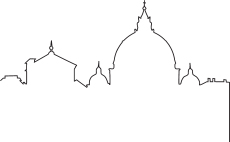
Chapter Six
Pius’s Gamble
The history of human institutions is a record of ephemeral lives, often with violent ends. The Golden Age of Athens, which gave birth to our greatest sculptures, as well as Socrates, Plato, and Aristotle, ended in the bloodbath of Syracuse and the Peloponnesian Wars in less than one hundred years. The long reign of Rome and the most long-lasting of Chinese and Egyptian Dynasties never reached or barely survived one thousand years. In the entire history of man, only two human institutions approach continuous existence and succession for more than two thousand years: the Japanese Imperial Succession and the papacy.
To approximately 1.2 billion human beings today, the pope is both supreme in all matters relating to the Church and infallible when, as pope, he promulgates teaching on matters involving faith and morals. Why is Rome the “headquarters” for Catholicism? On first impression, it seems an unlikely choice. Its first and most significant contact with Christianity was the criminal condemnation and crucifixion of Christ by a Roman procurator. Rome has, at best, slight biblical connections — a letter from Saint Paul to the small Roman church, an account of Paul’s beheading there by Nero, and allusions to Rome as an evil Babylon. Moreover, in Christianity’s early years, Rome butchered Christians without mercy.
Ephesus, Antioch, or especially Jerusalem would seem to have a far better historical claim to be the capital of Christianity. Except for Peter. Fundamental to the legitimacy of the pope is the belief that Peter was made head of the Church by Christ, who gave him the keys to the kingdom of heaven: “And so I say to you, you are Peter, and upon this rock I will build my church, and the gates of the netherworld shall not prevail against it. I will give you the keys to the kingdom of heaven. Whatever you bind on earth shall be bound in heaven, and whatever you loose on earth shall be loosed in heaven” (Mt 16:18–19).
Catholics believe that Peter, in turn, passed on this authority to a line of successors — the popes — who succeeded to his authority, in what is known as apostolic succession. There have been 266 popes, one after another, each ruling under Peter’s mandate. The first 31 popes (with only one exception) were executed by the Romans. Even despite a brief, tumultuous, sixty-eight years when the popes ruled from Avignon in France, the papal line has continued unabated, with a clear connection to Peter and to Rome.
The papacy’s tie to Rome, though not foundational to the Catholic faith, has deep emotional, religious, and even political roots, and has been such an enduring part of the Church’s tradition that its invalidation would be a deeply unsettling discovery. Even worse, if scientific evidence proved the long-held tradition of Peter’s burial beneath the Vatican to be false, it could cause people both within and outside of the Church to call into question much more fundamental Church teachings. Pius XII, 260th in the long-claimed succession of Peter, certainly recognized this danger. If the excavations proved that Peter had never been in Rome, the Church’s credibility in other matters — especially after centuries of upheaval — might become subject to serious doubt. If Peter never really came to Rome — if he was never really the leader of a Christian community there and never really passed along his authority to a Roman successor — even the pope’s authority and credibility could more easily be called into question.
Various prior and small-scale excavations by Pius’s predecessors had totally failed to find Peter. Although they had been conducted in secret, the excavations in the sixteenth and seventeenth centuries had eventually become known to the public, giving critics fodder to cast some doubt on papal legitimacy. Faced with growing skepticism in the twentieth-century world, no doubt exacerbated by the chaos of worldwide war, Pius chose to take one of the great gambles in human history — excavating under the Vatican itself to prove or disprove Peter’s arrival and death in Rome. Although he would seek to keep the excavations secret, he must surely have known that the results would leak out, as with the earlier efforts.
Pius’s decision was a strange and wild bet for a man known to be conservative and risk-averse in most every other way. Why? Almost certainly it was no gamble at all to Pius. He had an almost irrational, unwavering faith that Peter was there and would be found. Christ told Peter (the Rock) that he would build his Church upon him. Pius firmly believed this statement to be both a symbolic truth and a literal one. He believed that Christendom’s greatest church was constructed over Peter’s physical remains. The immense search would prove him right — or wrong.